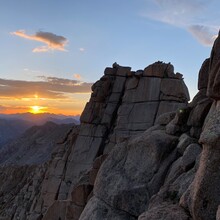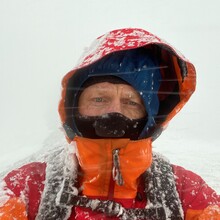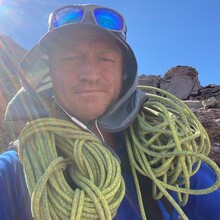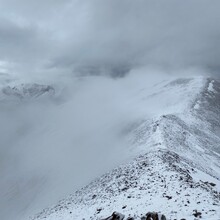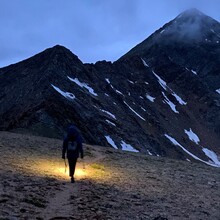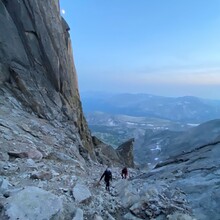A full report will be eventually be available at www.andrewhamilton.com/14ers/Centennials2021
The trip was closely tracked in a lengthy thread on 14ers.com
3000 Rule and Support
I chose to use support for this fkt, but it was limited by the 3000 foot rule. The basic idea is that if you are within 3000 feet elevation of the summit of one of the peaks you can't receive any kind of support. If you are below the 3000 foot level then you are free to receive support. You can never drive to start hiking to any point that will make the climb less than 3000 feet, and you must also descend 3000 feet from a peak before getting back in a support vehicle. The 3000 foot rule does have some downsides. For example in the Tenmile/Mosquito range in order to satisfy the rule, in several places you must hike many additional miles in order to drop low enough to get 3000 feet below the peaks. However the beauty of the 3000 foot rule is that it forces the athlete to navigate on their own, carry their own gear, and to be completely self-reliant while in that 3000 foot zone. The 3000 foot rule also has a long history in Colorado and there is a long standing precedent for using it when climbing peaks in Colorado.
The beauty of a supported attempt for this record, as opposed to a self-supported attempt, is that it opened up countless routes that would not have been available if the I was forced to return to the same location after every climb in order to get back to my vehicle. This allowed me to focus on creative routes that allow for the most elegant, efficient, and amazing routes throughout the mountains on the list.
I used a support crew with one person, Andrea Sansone, who was supporting me for the entire attempt. Other crew members rotated in and out depending on their availability. Thanks to Vince Noone, Laura Koepke, and David Koepke all who joined in and helped for over a week. Some of the responsibilities of the crew were carrying my pack to the 3000 foot rule point on certain hikes, forcing me to eat as much and as often as possible, driving me from trailhead to trailhead, and taking care of all the injuries that I sustained during the attempt.
Getting to the Start
I spent about 5 years planning for this record attempt, with many trips to the mountains to check out theoretical link-ups between the peaks. The linkups between the 14ers are pretty well known, however many of the linkups between the Centennial peaks or between the Centennial peaks and the 14ers are routes that are not done very often. In many places I was just making it up, hoping that there would be a way through cliffs in order to make routes work. In some cases I had taken a look at a route from far away, then during the record attempt I just went for it hoping that it would work out in the end.
Several obstacles presented themselves just before I began.
First, I learned that the Decalibron peaks (3 official and one unofficial Centennial) were legally closed. I wasn’t sure how to handle this originally. I figured since this was a public attempt, that I couldn’t illegally do the peaks and post it because it could hurt efforts to open the peaks to the public. I came up with the idea of doing the next 3 highest peaks in Colorado and skipping the Decalibron peaks. I figured I would hike up as far as was legally possible on the Decalibron peaks as well. I didn’t like the solution because of the “asterisk” involved, even though I would be hiking extra in order to deal with the problem. In the meantime our friend Kyle offered to start the process of getting us in touch with the landowner to try to secure permission to climb the peaks. Because of this issue I completely rearranged my plan. I decided that since I may not be able to complete the Centennials completely, that I would add two sub fkts into my attempt. I figured I could beat the Centennial Elks traverse time I had set with Andrea a few years ago, and I decided to try a new route I have had in mind, basically a Nolan’s on steroids route that I call the Weminuche Wipeout. Doing these routes added much effort to the overall time, and it forced me to change my starting location (originally the clock would have started after a long hike to the base of Vestal Peak).
In the end I climbed the extra peaks and we received last minute permission from the landowner to climb Decalibron. So I did the extra peaks Niagara, American, and Trinity during this record in addition to the Centennials along with several unofficial peaks as well.
Another obstacle that we faced was scheduling Culebra and Red Mountain. Several years back we were able to get permission to come into Culebra and they allowed us great flexibility with what time we showed up. However over the last few years the rules changed and this year they granted no flexibility. In order to climb Culebra we needed to be sure to show up on the date we had paid for and by 6:00 in the morning. If we were late we would not be allowed to climb. Because I had already decided to rearrange the plan to allow for a “Weminuche Wipeout” I realized it would be nearly impossible to guarantee getting to Culebra on time. To deal with this added stressor I decided to start with Culebra. Once finished we wouldn’t have to worry about getting there by a certain time and that relieved a lot of stress, although it certainly was not very efficient.
Another huge obstacle that presented itself was a massive change in the weather forecast right before I started. A few days before we were supposed to start, the skies were filled with smoke and it seemed like dealing with smoke in the air would be a big part of the challenge. However without much warning a massive change in the weather was forecast to bring huge amounts of moisture into the state. The monsoons had come early! And it came with cold air from the north, so snow was predicted every single night for over a week.
Finally there were several road closures that we found out that directly affected our route. The plan had to be adjusted to account for these new obstacles.
Starting in Snow
We started on Sunday July 27th on Culebra and Red Mountain. Although there were a couple of inches of fresh snow and it was slightly drizzling as I began the climb, it was still a pleasant climb. However I realized the plan to head deep into the San Juans for the “Weminuche Wipeout” just couldn’t happen. Doing the Wham Ridge on Vestal or climbing Jagged with several inches of fresh snow would just be way too dangerous. So we came up with a plan B: head to the Sawatch. I have completed Nolans several times and the Sawatch feels like home base. I figured I could hide out in the Sawatch for a few days and hope for drier weather pattern to develop.
On the way to the Sawatch we decided to go and climb Phoenix, San Luis, and Stewart, a set of San Juan peaks that I figured was an easy ridge walk that could be completed on the same day as Culebra. When I started Phoenix, the afternoon sun was out and it was hot. Because of this I let my guard down and did not bring as much warm gear as I could have. Nearing the summit of Phoenix it started to rain and it thoroughly soaked me. Thankfully I had brought my heavy Goretex rain jacket, and not a superlight one. At the summit of Phoenix I still had over an hour of daylight, but a cold wind was blowing hard and the rain turned into snow. With the wind and snow it felt like blizzard conditions that you might encounter in winter. I had a hard time staying on the ridge because of the poor visibility, and my hands were so cold getting the phone out to check my location on the map was not something I wanted to do. But I had to often because multiple times I accidentally started descending off the main ridge but I just couldn’t tell because of the storm. The snow continued until literally ever rock was covered by several inches of snow. The ridge to San Luis had far more ups and downs than I was expecting, so it took me several hours to just get to the saddle with San Luis.
At this point the weather cleared, but the cold wind kept blowing all night and I was surprised by the depth of the snow on San Luis, and on Stewart. The snow continued all the way down into the willows of Nutras Creek. By the time I had bushwhacked my way out and found the trail, I was thoroughly disheartened and planned on quitting. It didn’t seem like it was still day one, the effort of just surviving the night made the hike up Culebra seem like it had been days before.
Several of my foot tendons were hurting after hiking on the snow all night as the snow makes the footing unpredictable. I figured we could just stop the attempt and spend the next few weeks on a family vacation.
When I finally got to the trailhead, it was dawn. My pack was still frozen, my shoelaces were frozen solid, my hands felt like they had been frozen and it was hard to move them. Vince snapped a picture of me as I neared the support vehicles and it is quite astonishing in that behind me the summits of San Luis and Stewart are solid white. I told Andrea that I didn’t see how I could continue in the face of another week or more of weather like this. But she wouldn’t hear of it and convinced me to just try to continue in the Sawatch. If you are looking for sympathy it is best to find it from someone other than Andrea…
We drove to the Sawatch and I completely changed my way of thinking. From this point forward I never knew how many days I had been climbing, or how many peaks I had climbed. It was literally just one day at a time. The intricate schedule and plan I had created as our guide through the Centennials was completely discarded. We relied heavily on weather reports to avoid climbing certain peaks in bad weather. Our friend and weather expert Chris Tomer was sending us daily weather reports so we could choose what peaks to battle in the bad weather.
Battle with Injuries and Swelling
When Chris said the Elks looked good, we immediately headed out of the Sawatch and I did the massive Centennial Elks traverse. This is probably the most technically difficult Centennial linkup in the state. In one massive two day push you get 5 spectacular, dangerous high traverses, the easiest is the well-know Maroon Bells traverse. However after such a hard effort my body started to rebel and the new battle was against my own body. My legs were swelling from all the trauma, I combatted this when I was in the support vehicle by wearing some inflatable leg compressors. These keep the blood in the legs circulating and help with swelling and recovery. However it seemed that the inflammation was moving into the rest of my body. My face was feeling swollen and I was having trouble breathing. I would often sit up with an uncontrollable coughing fit feeling like I was going to suffocate on my own phlegm. My sister had just joined up with us, and she and Andrea bought some medications to help with the breathing issues. Somehow over the next few days we were able to get the inflammation under control and I was able to continue. Somehow my body worked through the inflammation problem and it didn’t really affect me again.
Fearing the Nights
Over the next couple of weeks I really began to dread the night. My hope had been to get about 4 hours of sleep every night. So ideally I would get back to the support crew by midnight, sleep for 4 hours, then head off at first light. However it seemed like most nights I would end up on a route that took longer than expected and I would often end up “Bumbling around in the dark” for the entire night. The worst case was when I would get back to the support crew at first light, then need to sleep for a few hours wasting precious daylight hours.
I’ll never forget those seemingly endless nights. Some of the worst in addition to that first night were on Half Peak, Jupiter, Capitol Peak, California, Clinton, and Ice Mountain. On Half Peak I spent literally the entire night bushwacking. On Capitol even though I have climbed the peak almost 20 times, in the dark I just couldn’t find the route, and wasted hours looking for cairns. On top of Blanca I remember seeing California peak and being horrified at how far away it seemed, with a light rain making the entire ridge just ever so slippery and darkness coming within a couple of hours. On Clinton I had no idea that the entire descent was miles of willow swamp. On Ice Mountain and North Apostle I just couldn’t figure out where to go, so I had to lay down for a couple of hours and wait until light in order to figure out the route.
Hitting Rock Bottom
I hit my mental and physical low and it was out of nowhere when it hit. The day started with a great forecast to climb in the Sangre De Cristos. We headed to the trailhead for Kit Carson and Challenger. I started the day by climbing Mt Adams, a nearby Centennial. I wasn’t feeling my strongest, but I think I was still moving fast enough that I wasn’t disappointed. After Mt. Adams I climbed Challenger, took the direct class 4 route to the summit of Kit Carson, then continued over Columbia Point. I climbed a bonus peak called Obstruction Mountain just to avoid an annoying stretch of contouring, then climbed the Northwest Couloir of Crestone Peak, following by the classic traverse over to Crestone Needle, followed by an annoyingly tedious descent of the needle via Broken Hand pass.
Now there was just one peak left for the day, arguably the easiest of the bunch, Humboldt Peak. I crossed by South Colony Lakes at 12,700 feet then left my pack behind so I could make some good time up Humboldt. I was trying to get up to the summit in the light, it was going to be a race. It had been a pretty smoky day, and the sunset was really neat as the sun just looked like a glowing red ball as it slowly disappeared into nothingness.
I made the summit with about 20 minutes of daylight to spare. The weather seemed fine still although I did notice some strange clouds starting to hover near the summits of the surrounding peaks. I have found through experience that descending Humboldt can be a little tricky in the dark so I was hurrying as much as possible to descend as far as I could before it was completely dark. Soon it was dark, and when I was about a half mile from my pack there was a large bolt of lighting that lit up the night sky with a loud boom of thunder. I quickened my pace but within the next few minutes another bolt lit up the sky and a few drops of rain started falling. Then another loud boom and it started hailing. Now I was running as fast as I could, by the fourth lightning strike it was a complete downpour, with some of the hailstones as large as small marbles. Getting pounded by the hail, I dove under the first small pine tree I could find but it didn’t provide much cover, so after a minute or two I ran for my pack, but by the time I found it I was completed soaked and demoralized. After getting on my rain jacket and gloves I started down the trail again now completely covered in rain and hail. The willows for the next mile were soaked, which meant I was soaked.
I arrived at the old upper South Colony Lakes trailhead, where Andrea had left my bike earlier in the day. Biking down the road to the 2wd trailhead is very fast so I was excited to get to my bike, however everything was wet and covered in hail. The first two and a half miles of the descent is very rocky, and for the most part I did great. However in one spot that wasn’t even that rocky I crashed hard going right over my handlebars. It was a strange experience as I remember stopping in midair with my face inches from the ground. It was as if that moment in time had stopped, and I was able to leisurely put my hands down to prevent my face from smashing into the ground. Then the rest of my body crashed to the ground, and what seemed like several seconds later I heard my bike smash into the ground. I just laid there thinking how comfortable the ground felt, thinking I should just take a nap. I closed my eyes for I am not sure how long exactly, but then realized I was laying in running water, it wasn’t a stream but just runoff from the recent storm.
As I stood up I realized I must have injured my calf muscle in the crash. If I even barely flexed it, it would immediately seize up. Now the only thing that mattered in my universe was to get to a position where the calf wasn’t seizing up because it hurt so bad. I spent the rest of the ride just coasting not able to pedal the bike because that would trigger the calf muscle to seize up.
When I reached the car Andrea was sleeping so I banged on the door and then just fell on my bike, moaning in agony trying to describe to Andrea what had happened. Fortunately we had planned to get a room in Westcliffe that night, so she immediately drove me to the hotel in Westcliffe, and I limped in and made my way into the bathtub.
I was too weak to do anything but lay on my side as warm water filled the tub. I didn’t want to move at all because any movement in the calf would trigger the seizing of the muscle that was so painful.
The pain felt a lot like a muscle that was cramping up, and I surmised that when I crashed the bike, the pedal had hit the calf muscle very hard. I thought maybe an extra dose of electrolytes would help. Andrea brought me a jar of pickles, and I ate a couple of pickles and drank some pickle juice, Andrea was trying to get me to eat, but now I felt hot and nauseous. I am not sure exactly what happened but all of a sudden I started throwing up all over myself. Heave after heave and soon I was in a bath of puke. Thank goodness I was in the bathtub when the nausea hit! I felt so weak, I just laid in the tub for hours feeling drained and sick and not wanting to move my calf. Climbing even one more mountain seemed like an impossibility.
Eventually Andrea was able to get me into the bed to try to sleep, but now I was hit with several bouts of diarrhea, so I had to make several trips to the bathroom, but moving around with my calf muscle damaged was very painful.
We decided that I would have to take a recovery day. After trying to get some good sleep we would drive to Pikes Peak and try it in the afternoon. Pikes has a nice trail so if there was any peak I was going to be able to do on that bad calf muscle, that would be the one. And if I couldn’t do it, I would have to quit right there. The other issue I was facing was I couldn’t eat anything, as the thought of any food made me want to throw up.
Andrea climbed Pikes with me to keep me company, but I still remember that hike with dread. It seemed to go on forever, and I was very weak because I didn’t want to eat any food. However by the end of the hike my calf, although quite sore, was not so painful that I thought it would stop me. I think it was one of those injuries where it may have been sore for weeks if I had just stopped after getting the injury, but by keeping it active I think it may have healed much faster. Over the next week it quickly recovered so that it wasn’t bothering me at all by the end of the record attempt.
The next day, despite being weak physically and with the sore calf I headed off for another very tough day. Another day in Sangres as I traversed from Huerfano and Lindsay to Blanca via the Gash Ridge, then out and back to Little Bear via the astonishingly exposed Little Bear – Blanca traverse. (In addition to being weak from the previous day, this day took place almost entirely on ridges so I had almost no water available to me for the entire day. I was able to climb down to some snow in a couloir on the Little Bear –Blanca ridge to get some snow to mix with some water in my waterbottle) Then miles of ridge travel north up and over Ellingwood Point on the way to California Peak across tedious ridges. Fortunately I made it across the Little Bear -- Blanca ridge ahead of the rain, but then I had a light rain making the ridges to Ellingwood and California ever so treacherous and slippery. It was a tough day coming after the previous days’ disaster, and I spent all night traversing to California Peak and then descending back to the car. But despite all that Andrea and I knew that the last really difficult day of climbing was behind us, so the future looked bright.
Getting Stronger
Through all these tough nights we persevered. Now we had to finish up the Sawatch peaks, then move into the Tenmile Mosquitos, and finally the Front range. It was a little unreal to hit peaks like Sherman and Quandary on weekend mornings. I was so used to being completely by myself that it was a shock to get to those mountains and see lines of people, hundreds of them, moving slowly up the more popular 14ers. It felt like playing people slalom as I weaved past many people on the way up the peaks, my uphill legs finally feeling powerful.
Finally on my last day I felt strong and motivated. The air was full of smoke but I moved fast as I climbed the peaks of the front range, the appetizer for the grand finale with Longs. In the past Longs has usually been ready for me with hailstorms and snow. So I raced and fought for every minute, because every minute saved was one more minute of light for the hike up Longs. After battling Torreys, Grays, Edwards, Evans, and Bierstadt, we made it to Longs with about three and a half hours of light to work with.
The Finish
Andrea and I were joined by Max Manson on our climb up Longs and Meeker. Max knew all the short cut routes below treeline and we made great time up the loft route to the summit of Meeker. Then we quickly made our way past Clarks Arrow and made the summit of Longs with a couple of minutes of daylight to spare. The weather was beautiful. I didn’t know it at the time but I was extremely lucky to finish this day as a huge surge of monsoon moisture would be pouring into the state over the next couple of days.
We descended the keyhole route of Longs, still a slow, tedious descent in the dark even with the perfect weather. When we finally reached the trail we sprinted down to the finishing location, 3000 feet below the summit of Longs, greeted by a few friends and my kids who had hiked up with my sister and brother-in-law.
Somehow after all the setbacks we had finished. I had literally been ready to quit on day 1 but here we were and it didn’t even seem real. Over the next several days I became depressed and super tired and felt like my brain was in a fog as I tried to adjust to coming back to the real world.
I consider this record as much Andrea’s as mine because she did so much over the 3 weeks. Just like I never stopped, she never stopped and there was just no way I could have finished this without her.

